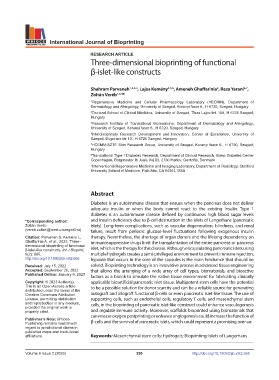Page 264 - IJB-9-2
P. 264
International Journal of Bioprinting
RESEARCH ARTICLE
Three-dimensional bioprinting of functional
β-islet-like constructs
Shahram Parvaneh 1,2,3,4 , Lajos Kemény 1,3,5 , Ameneh Ghaffarinia , Reza Yarani ,
6,7
5
Zoltán Veréb 1,3,4 *
1 Regenerative Medicine and Cellular Pharmacology Laboratory (HECRIN), Department of
Dermatology and Allergology, University of Szeged, Koranyi fasor 6., H 6720, Szeged, Hungary
2 Doctoral School of Clinical Medicine, University of Szeged, Tisza Lajos krt. 109, H 6725 Szeged,
Hungary
3
Research Institute of Translational Biomedicine, Department of Dermatology and Allergology,
University of Szeged, Koranyi fasor 6., H 6720, Szeged, Hungary
4 Interdisciplinary Research Development and Innovation, Center of Excellence, University of
Szeged, Dugonics tér 13., H 6720 Szeged, Hungary
5 HCEMM-SZTE Skin Research Group, University of Szeged, Koranyi fasor 6., H 6720, Szeged,
Hungary
6 Translational Type 1 Diabetes Research, Department of Clinical Research, Steno Diabetes Center
Copenhagen, Borgmester Ib Juuls Vej 83, 2730 Herlev, Gentofte, Denmark
7 Interventional Regenerative Medicine and Imaging Laboratory, Department of Radiology, Stanford
University School of Medicine, Palo Alto, CA 94304, USA
Abstract
Diabetes is an autoimmune disease that ensues when the pancreas does not deliver
adequate insulin or when the body cannot react to the existing insulin. Type 1
diabetes is an autoimmune disease defined by continuous high blood sugar levels
*Corresponding author: and insulin deficiency due to β-cell destruction in the islets of Langerhans (pancreatic
Zoltán Veréb islets). Long-term complications, such as vascular degeneration, blindness, and renal
(vereb.zoltan@med.u-szeged.hu) failure, result from periodic glucose-level fluctuations following exogenous insulin
Citation: Parvaneh S, Kemény L, therapy. Nevertheless, the shortage of organ donors and the lifelong dependency on
Ghaffarinia A, et al., 2023, Three- immunosuppressive drugs limit the transplantation of the entire pancreas or pancreas
dimensional bioprinting of functional
β-islet-like constructs. Int J Bioprint, islet, which is the therapy for this disease. Although encapsulating pancreatic islets using
9(2): 665. multiple hydrogels creates a semi-privileged environment to prevent immune rejection,
http://doi.org/10.18063/ijb.v9i2.665 hypoxia that occurs in the core of the capsules is the main hindrance that should be
Received: July 15, 2022 solved. Bioprinting technology is an innovative process in advanced tissue engineering
Accepted: September 26, 2022 that allows the arranging of a wide array of cell types, biomaterials, and bioactive
Published Online: January 9, 2023 factors as a bioink to simulate the native tissue environment for fabricating clinically
Copyright: © 2023 Author(s). applicable bioartificial pancreatic islet tissue. Multipotent stem cells have the potential
This is an Open Access article to be a possible solution for donor scarcity and can be a reliable source for generating
distributed under the terms of the
Creative Commons Attribution autograft and allograft functional β-cells or even pancreatic islet-like tissue. The use of
License, permitting distribution supporting cells, such as endothelial cells, regulatory T cells, and mesenchymal stem
and reproduction in any medium, cells, in the bioprinting of pancreatic islet-like construct could enhance vasculogenesis
provided the original work is
properly cited. and regulate immune activity. Moreover, scaffolds bioprinted using biomaterials that
can release oxygen postprinting or enhance angiogenesis could increase the function of
Publisher’s Note: Whioce
Publishing remains neutral with β-cells and the survival of pancreatic islets, which could represent a promising avenue.
regard to jurisdictional claims in
published maps and institutional
affiliations. Keywords: Mesenchymal stem cells; Hydrogels; Bioprinting; Islets of Langerhans
Volume 9 Issue 2 (2023) 256 http://doi.org/10.18063/ijb.v9i2.665

